(word完整版)五年级英语(上)句型转换规则归纳,推荐文档
- 格式:doc
- 大小:35.01 KB
- 文档页数:2
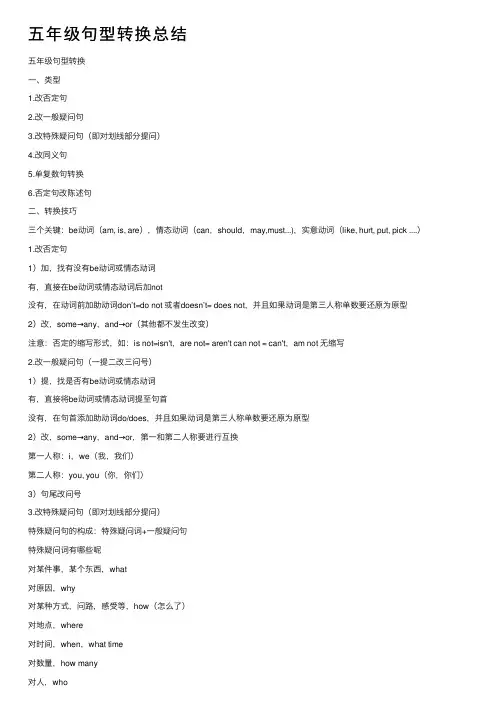
五年级句型转换总结五年级句型转换⼀、类型1.改否定句2.改⼀般疑问句3.改特殊疑问句(即对划线部分提问)4.改同义句5.单复数句转换6.否定句改陈述句⼆、转换技巧三个关键:be动词(am, is, are),情态动词(can,should,may,must...),实意动词(like, hurt, put, pick ....)1.改否定句1)加,找有没有be动词或情态动词有,直接在be动词或情态动词后加not没有,在动词前加助动词don’t=do not 或者doesn’t= does not,并且如果动词是第三⼈称单数要还原为原型2)改,some→any,and→or(其他都不发⽣改变)注意:否定的缩写形式,如:is not=isn't,are not= aren't can not = can't,am not ⽆缩写2.改⼀般疑问句(⼀提⼆改三问号)1)提,找是否有be动词或情态动词有,直接将be动词或情态动词提⾄句⾸没有,在句⾸添加助动词do/does,并且如果动词是第三⼈称单数要还原为原型2)改,some→any,and→or,第⼀和第⼆⼈称要进⾏互换第⼀⼈称:i,we(我,我们)第⼆⼈称:you, you(你,你们)3)句尾改问号3.改特殊疑问句(即对划线部分提问)特殊疑问句的构成:特殊疑问词+⼀般疑问句特殊疑问词有哪些呢对某件事,某个东西,what对原因,why对某种⽅式,问路,感受等,how(怎么了)对地点,where对时间,when,what time对数量,how many对⼈,who对某⼈的,谁谁的,whose1)定,确定特殊疑问词2)看,看原句是否有be动词或情态动词有,特殊疑问词后接原句⾥的be动词或情态动词没有,特殊疑问句词后接助动词do/does,同时原句三单要改为原形3)改(抄),some→any,and→or,第⼀和第⼆⼈称进⾏互换4)补,如果划线部分有动词,要将其改为do的适当形式如:I often go to the park at weekends.1)定,对某事提问,定what2)看,原句⽆be/情态动词,所以⽤do, what do3)改(抄),i→you, What do you often at weekends4)补,因为划线部分有动词go,补上do,What do you often do at weekends特殊注意:1. 当划线部分为在句⾸的某⼈,⽤who提问时,不遵循上述规律,who后原句有情态动词⽤情态动词,没有⽤动词三单如:She can’t go to the party. → Who can’t go to the party She helps the girl. →Who helps the girlThe boys are singing. → Who is singsing2.There be 句型的划线部分提问,问某地有什么不管单数复数,⽤what’s或what is如:There are some desks in the classroom.What’ s in the classroom3.Whose的划线部分提问Whose + 名词+ 其他如:This is his book. → Whose book is this4.Why 的特殊疑问句⼀般遵循上述技巧,但是当原句存在否定时,有两种表述。
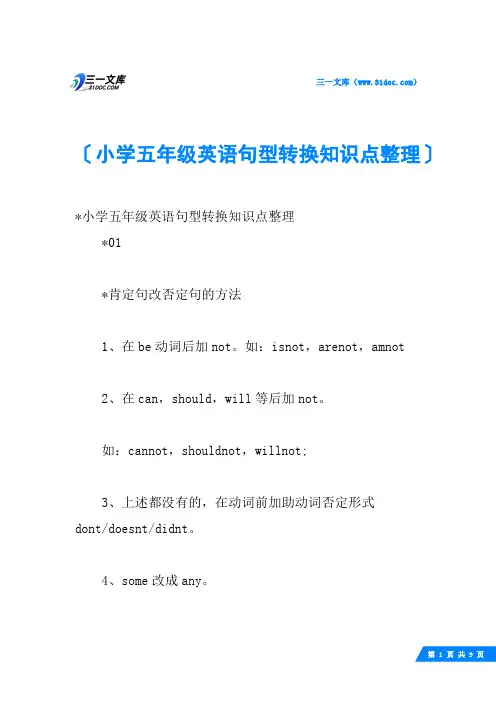
三一文库()〔小学五年级英语句型转换知识点整理〕*小学五年级英语句型转换知识点整理*01*肯定句改否定句的方法1、在be动词后加not。
如:isnot,arenot,amnot2、在can,should,will等后加not。
如:cannot,shouldnot,willnot;3、上述都没有的,在动词前加助动词否定形式dont/doesnt/didnt。
4、some改成any。
如:Iamagirl.Iamnotagirl.Youareastudent.Youarenotastudent.Youarentastudent.ThisisTomsbag,ThisisnotTomsbag.ThisisntTomsbag.*02*肯定句改一般疑问句的方法1、把be动词放在句首,剩下的照抄,(some改成any,I改成you,my改成your)句点改成问号。
2、把can,shall,will等放到句首,剩下的照抄,(some 改成any,I改成you,my改成your)句点改成问号。
3、上述都没有的,在句首请助动词Do/Does/Did帮忙,剩下的照抄,(some改成any,I改成you,my改成your)句点改成问号。
注意:句首的第一个字母要大写,句尾标点应为“?”。
如:IaminClass6.AreyouinClass6?YouarefromAmerica.AreyoufromAmerica?Itisanorange.Isitanorange?4、就一般疑问句回答一般疑问句有两种回答,即:肯定回答和否定回答。
其中,肯定回答用yes,否定回答用no。
语句顺序为:Yes+主语+am/is/are/was/were.|can.|do/does/did|;No+主语+amnot/isnt/arent如:—AreyouanEnglishteacher?Yes,Iam./No,Iamnot.—Isthatabird?Yes,itis./No,itisnt.*03*对划线部分提问“就划线部分提问”是小学阶段英语学习的难点,但是一旦掌握了规律,就变得容易多了。
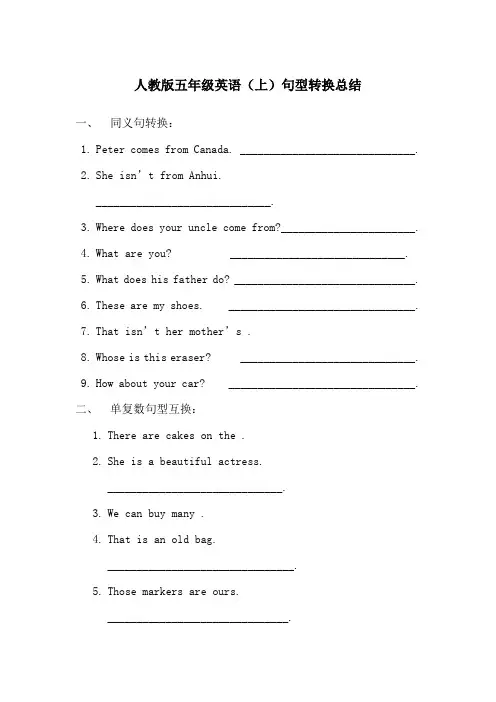
人教版五年级英语(上)句型转换总结一、同义句转换:1.Peter comes from Canada. ______________________________.2.She isn’t from Anhui.______________________________.3.Where does your uncle come from?_______________________.4.What are you? ______________________________.5.What does his father do? _______________________________.6.These are my shoes. ________________________________.7.That isn’t her mother’s .8.Whose is this eraser? ______________________________.9.How about your car? ________________________________.二、单复数句型互换:1.There are cakes on the .2.She is a beautiful actress.______________________________.3.We can buy many .4.That is an old bag.________________________________.5.Those markers are ours._______________________________.6.They love us._______________________________.7.He doesn’t like watching .8.Where does she work?__________________________________.9.Whose balloons arethese?_______________________________.三、肯定句、否定句、一般疑问句、特殊疑问句转换:1.He is a policeman.________________________________.(否定句)________________________________?(一般疑问)________________________________?(特殊疑问)2.I’m good at singing and dancing.__________________________________________.(否定句)__________________________________________?(一般疑问)__________________________________________?(特殊疑问)3.They are playing a bear.__________________________________.(否定句)__________________________________?(一般疑问)__________________________________?(特殊疑问)4.We should learn from him.___________________________________.(否定句)___________________________________?(一般疑问)___________________________________?(特殊疑问)5.Tom can find his brother’s mask.___________________________________.(否定句)___________________________________?(一般疑问)___________________________________?(特殊疑问)6.We have new friends in our class.___________________________________________.(否定句)___________________________________________?(一般疑问)___________________________________________?(特殊疑问)7.You want to be a doctor like my dad._______________________________________.(否定句)_______________________________________?(一般疑问)_______________________________________?(特殊疑问)8.She works in a hospital.________________________________.(否定句)________________________________?(一般疑问)________________________________?(特殊疑问)参考答案:一、1. Peter is from Canada.2. She doesn’t come from Anhui.3. Where is your uncle from?4. What are your job? / What do you do?5. What is his father ?/ What is his father’s job?6. These shoes are mine.7. That isn’t her mother’s bike.8. Whose eraser is this?9. What about your car?二、is a cake on the table.2. They are beautiful actresses.3. I can buy a story-book.4. Those are old bags.marker is mine.She loves me.7. They don’t like watching TV.8. Where do they work?balloon is this?三、1. He isn’t a policeman. Is he a policeman? What is he?2. I’m not good at singing and dancing. Are you good at singing and dancing?What are you good at?3. They aren’t playing a bear. Are they playing a bear? What are they playing?4. We shouldn’t learn from him. Should you learn from him?Who should you learn from?5. Tom can’t find his brother’s mask. Can Tom find his brother’s mask?Whose mask can Tom find?6. We don’t have new friend s in our class. Do you have new friends in your class?Where do you have new friends?7. You don’t want to be a doctor like my dad.Do you want to be a doctor like my dad? What do you want to be like my dad?8.She doesn’t work in a hospital. Does she work in a hospital?Where does she work?。
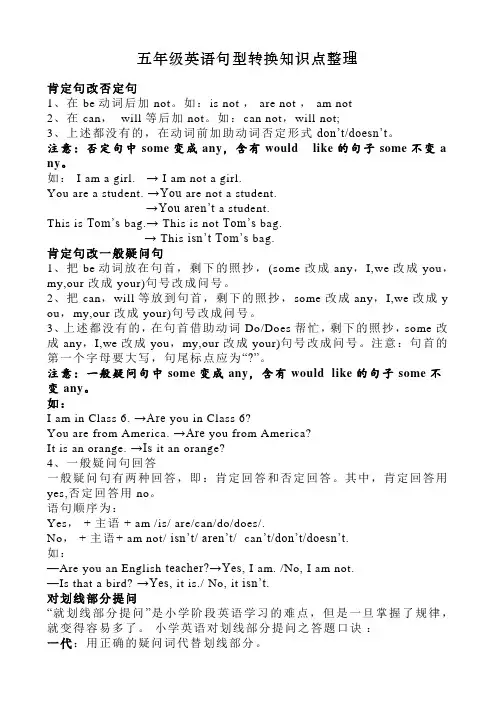
五年级英语句型转换知识点整理肯定句改否定句1、在be动词后加not。
如:is not , are not , am not2、在can,will等后加not。
如:can not,will not;3、上述都没有的,在动词前加助动词否定形式don’t/doesn’t。
注意:否定句中some变成any,含有would like的句子some不变a ny。
如: I am a girl. → I am not a girl.You are a student. →You are not a student.→You aren’t a student.This is Tom’s bag.→ This is not Tom’s bag.→ This isn’t Tom’s bag.肯定句改一般疑问句1、把be动词放在句首,剩下的照抄,(some 改成any,I,we改成you,my,our改成your)句号改成问号。
2、把can,will等放到句首,剩下的照抄,some 改成any,I,we改成y ou,my,our改成your)句号改成问号。
3、上述都没有的,在句首借助动词Do/Does帮忙,剩下的照抄,some 改成any,I,we改成you,my,our改成your)句号改成问号。
注意:句首的第一个字母要大写,句尾标点应为“?”。
注意:一般疑问句中some变成any,含有would like的句子some不变any。
如:I am in Class 6. →Are you in Class 6?You are from America. →Are you from America?It is an orange. →Is it an orange?4、一般疑问句回答一般疑问句有两种回答,即:肯定回答和否定回答。
其中,肯定回答用yes,否定回答用no。
语句顺序为:Yes, + 主语 + am /is/ are/can/do/does/.No, + 主语+ am not/ isn’t/aren’t/ can’t/don’t/doesn’t.如:—Are you an English teacher?→Yes, I am. /No, I am not.—Is that a bird? →Yes, it is./ No, it isn’t.对划线部分提问“就划线部分提问”是小学阶段英语学习的难点,但是一旦掌握了规律,就变得容易多了。
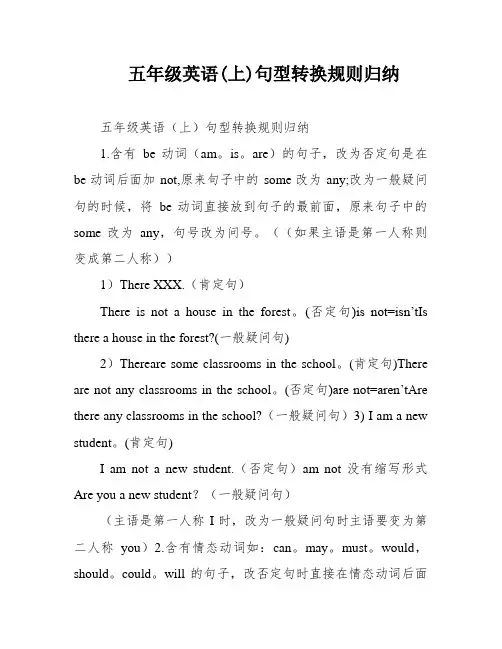
五年级英语(上)句型转换规则归纳五年级英语(上)句型转换规则归纳1.含有be动词(am。
is。
are)的句子,改为否定句是在be动词后面加not,原来句子中的some改为any;改为一般疑问句的时候,将be动词直接放到句子的最前面,原来句子中的some改为any,句号改为问号。
((如果主语是第一人称则变成第二人称))1)There XXX.(肯定句)There is not a house in the forest。
(否定句)is not=isn’tIs there a house in the forest?(一般疑问句)2)Thereare some classrooms in the school。
(肯定句)There are not any classrooms in the school。
(否定句)are not=aren’tAre there any classrooms in the school?(一般疑问句)3) I am a new student。
(肯定句)I am not a new student.(否定句)am not没有缩写形式Are you a new student?(一般疑问句)(主语是第一人称I时,改为一般疑问句时主语要变为第二人称you)2.含有情态动词如:can。
may。
must。
would,should。
could。
will的句子,改否定句时直接在情态动词后面加not,原来句子中的some改为any;改为一般疑问句的时候,将情态动词直接放到句子的最前面,原来句子中的some改为any,句号改为问号。
((如果主语是第一人称则变成第二人称))1)I can play basketball。
(肯定句)I can not play basketball。
(否认句)can not = can’tCan you play basketball。
(普通疑问句)3.不含有be动词,也没有情态动词的句子,改为否定句的时候需要借助助动词don’t和doesn’t来否定,原来句子中的some改为any;改为一般疑问句的时候需要借助Do。
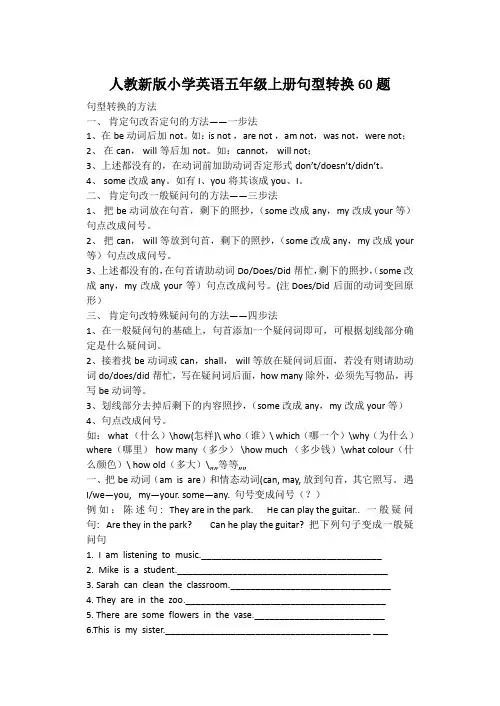
人教新版小学英语五年级上册句型转换60题句型转换的方法一、肯定句改否定句的方法——一步法1、在be动词后加not。
如:is not , are not , am not, was not, were not;2、在can, will等后加not。
如:cannot, will not;3、上述都没有的,在动词前加助动词否定形式don’t/doesn’t/didn’t。
4、 some 改成any。
如有I、you将其该成you、I。
二、肯定句改一般疑问句的方法——三步法1、把be动词放在句首,剩下的照抄,(some 改成any,my改成your等)句点改成问号。
2、把can, will等放到句首,剩下的照抄,(some 改成any,my改成your 等)句点改成问号。
3、上述都没有的,在句首请助动词Do/Does/Did帮忙,剩下的照抄,(some 改成any,my改成your等)句点改成问号。
(注 Does/Did后面的动词变回原形)三、肯定句改特殊疑问句的方法——四步法1、在一般疑问句的基础上,句首添加一个疑问词即可,可根据划线部分确定是什么疑问词。
2、接着找be动词或can,shall, will等放在疑问词后面,若没有则请助动词do/does/did帮忙,写在疑问词后面,how many除外,必须先写物品,再写be动词等。
3、划线部分去掉后剩下的内容照抄,(some 改成any,my改成your等)4、句点改成问号。
如: what (什么)\how(怎样)\ who(谁)\ which(哪一个)\why(为什么)where(哪里) how many(多少) \how much (多少钱)\what colour(什么颜色)\ how old(多大)\……等等……一、把be动词(am is are)和情态动词(can, may, 放到句首,其它照写。
遇I/we—you, my—your. some—any. 句号变成问号(?)例如:陈述句: They are in the park. He can play the guitar.. 一般疑问句: Are they in the park? Can he play the guitar? 把下列句子变成一般疑问句1. I am listening to music.____________________________________2. Mike is a student.__________________________________________3. Sarah can clean the classroom.________________________________4. They are in the zoo.________________________________________5. There are some flowers in the vase.__________________________6.This is my sister._________________________________________ ___7.We are sweeping the floor._________________________ _________二、借助助动词do/does,第三人称单数用does,其余人称用do,放到句首,其他照写。

五年级英语句型转换知识点整理肯定句改否定句1、在be动词后加not。
如:is not , are not , am not2、在can,will等后加not。
如:can not,will not;3、上述都没有的,在动词前加助动词否定形式don’t/doesn’t。
注意:否定句中some变成any,含有would like的句子some不变a ny。
如: I am a girl. → I am not a girl.You are a student. →You are not a student.→You aren’t a student.This is Tom’s bag.→ This is not Tom’s bag.→ This isn’t Tom’s bag.肯定句改一般疑问句1、把be动词放在句首,剩下的照抄,(some 改成any,I,we改成you,my,our改成your)句号改成问号。
2、把can,will等放到句首,剩下的照抄,some 改成any,I,we改成y ou,my,our改成your)句号改成问号。
3、上述都没有的,在句首借助动词Do/Does帮忙,剩下的照抄,some 改成any,I,we改成you,my,our改成your)句号改成问号。
注意:句首的第一个字母要大写,句尾标点应为“?”。
注意:一般疑问句中some变成any,含有would like的句子some不变any。
如:I am in Class 6. →Are you in Class 6?You are from America. →Are you from America?It is an orange. →Is it an orange?4、一般疑问句回答一般疑问句有两种回答,即:肯定回答和否定回答。
其中,肯定回答用yes,否定回答用no。
语句顺序为:Yes, + 主语 + am /is/ are/can/do/does/.No, + 主语+ am not/ isn’t/aren’t/ can’t/don’t/doesn’t.如:—Are you an English teacher?→Yes, I am. /No, I am not.—Is that a bird? →Yes, it is./ No, it isn’t.对划线部分提问“就划线部分提问”是小学阶段英语学习的难点,但是一旦掌握了规律,就变得容易多了。
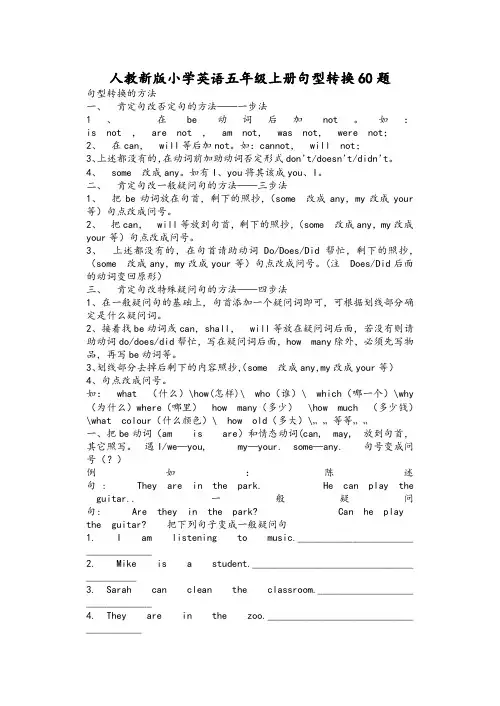
人教新版小学英语五年级上册句型转换60题句型转换的方法一、肯定句改否定句的方法——一步法1、在be动词后加not。
如:is not ,are not ,am not,was not,were not;2、在can,will等后加not。
如:cannot,will not;3、上述都没有的,在动词前加助动词否定形式don’t/doesn’t/didn’t。
4、some 改成any。
如有I、you将其该成you、I。
二、肯定句改一般疑问句的方法——三步法1、把be动词放在句首,剩下的照抄,(some 改成any,my改成your 等)句点改成问号。
2、把can,will等放到句首,剩下的照抄,(some 改成any,my改成your等)句点改成问号。
3、上述都没有的,在句首请助动词Do/Does/Did帮忙,剩下的照抄,(some 改成any,my改成your等)句点改成问号。
(注Does/Did后面的动词变回原形)三、肯定句改特殊疑问句的方法——四步法1、在一般疑问句的基础上,句首添加一个疑问词即可,可根据划线部分确定是什么疑问词。
2、接着找be动词或can,shall,will等放在疑问词后面,若没有则请助动词do/does/did帮忙,写在疑问词后面,how many除外,必须先写物品,再写be动词等。
3、划线部分去掉后剩下的内容照抄,(some 改成any,my改成your等)4、句点改成问号。
如:what (什么)\how(怎样)\ who(谁)\ which(哪一个)\why (为什么)where(哪里)how many(多少)\how much (多少钱)\what colour(什么颜色)\ how old(多大)\……等等……一、把be动词(am is are)和情态动词(can, may, 放到句首,其它照写。
遇I/we—you, my—your. some—any. 句号变成问号(?)例如:陈述句: They are in the park. He can play the guitar.. 一般疑问句: Are they in the park? Can he play the guitar? 把下列句子变成一般疑问句1. I am listening to music._______________________ _____________2. Mike is a student.________________________________ __________3. Sarah can clean the classroom.___________________ _____________4. They are in the zoo._____________________________ ___________5. There are some flowers in the vase.________ __________________6.This is my sister.____________________________________ _____ ___7.We are sweeping the floor._________________________ _________二、借助助动词do/does,第三人称单数用does,其余人称用do,放到句首,其他照写。
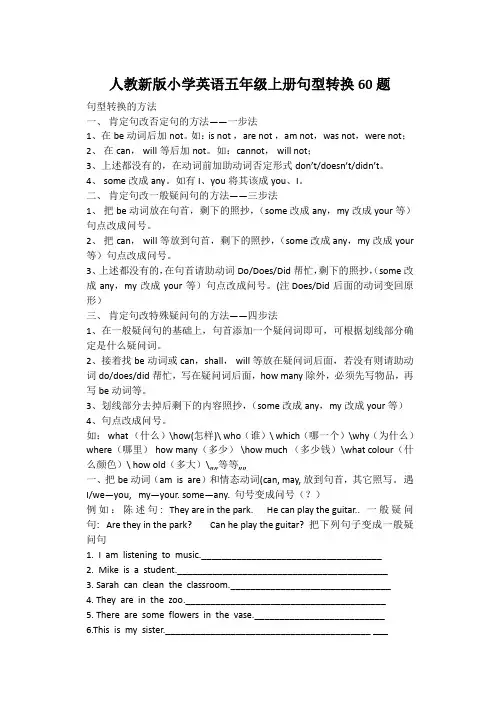
人教新版小学英语五年级上册句型转换60题句型转换的方法一、肯定句改否定句的方法——一步法1、在be动词后加not。
如:is not , are not , am not, was not, were not;2、在can, will等后加not。
如:cannot, will not;3、上述都没有的,在动词前加助动词否定形式don’t/doesn’t/didn’t。
4、 some 改成any。
如有I、you将其该成you、I。
二、肯定句改一般疑问句的方法——三步法1、把be动词放在句首,剩下的照抄,(some 改成any,my改成your等)句点改成问号。
2、把can, will等放到句首,剩下的照抄,(some 改成any,my改成your 等)句点改成问号。
3、上述都没有的,在句首请助动词Do/Does/Did帮忙,剩下的照抄,(some 改成any,my改成your等)句点改成问号。
(注 Does/Did后面的动词变回原形)三、肯定句改特殊疑问句的方法——四步法1、在一般疑问句的基础上,句首添加一个疑问词即可,可根据划线部分确定是什么疑问词。
2、接着找be动词或can,shall, will等放在疑问词后面,若没有则请助动词do/does/did帮忙,写在疑问词后面,how many除外,必须先写物品,再写be动词等。
3、划线部分去掉后剩下的内容照抄,(some 改成any,my改成your等)4、句点改成问号。
如: what (什么)\how(怎样)\ who(谁)\ which(哪一个)\why(为什么)where(哪里) how many(多少) \how much (多少钱)\what colour(什么颜色)\ how old(多大)\……等等……一、把be动词(am is are)和情态动词(can, may, 放到句首,其它照写。
遇I/we—you, my—your. some—any. 句号变成问号(?)例如:陈述句: They are in the park. He can play the guitar.. 一般疑问句: Are they in the park? Can he play the guitar? 把下列句子变成一般疑问句1. I am listening to music.____________________________________2. Mike is a student.__________________________________________3. Sarah can clean the classroom.________________________________4. They are in the zoo.________________________________________5. There are some flowers in the vase.__________________________6.This is my sister._________________________________________ ___7.We are sweeping the floor._________________________ _________二、借助助动词do/does,第三人称单数用does,其余人称用do,放到句首,其他照写。
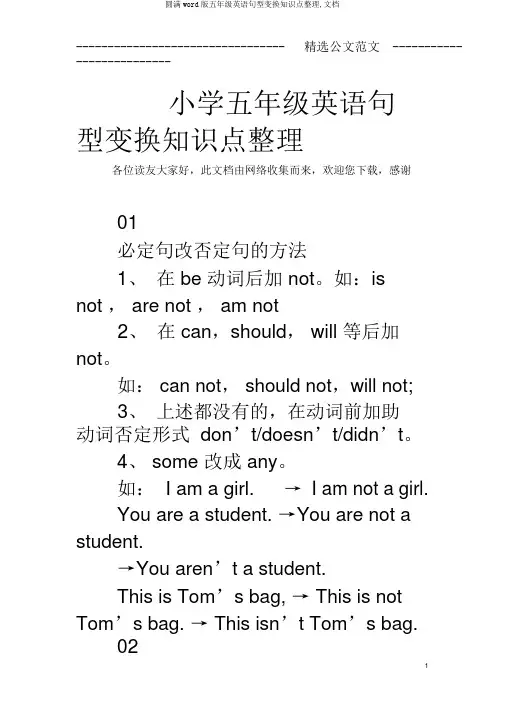
--------------------------------- 精选公文范文 --------------------------小学五年级英语句型变换知识点整理各位读友大家好,此文档由网络收集而来,欢迎您下载,感谢01必定句改否定句的方法1、在 be 动词后加 not。
如:isnot , are not , am not2、在 can,should, will 等后加not。
如: can not, should not,will not;3、上述都没有的,在动词前加助动词否定形式 don’t/doesn’t/didn’t。
4、 some 改成 any。
如: I am a girl.→ I am not a girl.You are a student. →You are not a student.→You aren’t a student.This is Tom’s bag, → This is not Tom’s bag. → This isn’t Tom’s bag.02---------------- 精选公文范文 ----------------必定句改一般疑问句的方法1、把 be 动词放在句首,剩下的照抄,(some 改成 any,I 改成 you,my 改成 your)句点改成问号。
2、把 can,shall, will 等放到句首,剩下的照抄,(some 改成 any,I 改成you, my 改成 your)句点改成问号。
3、上述都没有的,在句首请助动词Do/Does/Did 帮忙,剩下的照抄, (some改成 any,I 改成 you,my 改成 your)句点改成问号。
注意:句首的第一个字母要大写,句尾标点应为“?。
”如:I am in Class 6. →Are you in Class 6?You are from America. →Are you from America?It is an orange.→Is it an orange?4、就一般疑问句回答一般疑问句有两种回答,即:必定回答和否定回答。
![五年级英语(含答案)句型转换[1]](https://uimg.taocdn.com/8e952fd567ec102de3bd89ac.webp)
五年级英语(含答案)句型转换(word版可编辑修改)编辑整理:尊敬的读者朋友们:这里是精品文档编辑中心,本文档内容是由我和我的同事精心编辑整理后发布的,发布之前我们对文中内容进行仔细校对,但是难免会有疏漏的地方,但是任然希望(五年级英语(含答案)句型转换(word版可编辑修改))的内容能够给您的工作和学习带来便利。
同时也真诚的希望收到您的建议和反馈,这将是我们进步的源泉,前进的动力。
本文可编辑可修改,如果觉得对您有帮助请收藏以便随时查阅,最后祝您生活愉快业绩进步,以下为五年级英语(含答案)句型转换(word版可编辑修改)的全部内容。
按要求改写句子1.That’s a horse in English.(就画线部分提问)What’s_ that _ in English?2.What's on the desk? (回答问题)___There_____ ___is_____ a pen.3.What's this in Chinese? (同意句)What’s ___the _____ _Chinese_______ __for______this?4.Is it a horse?(肯定句)___It _____ ___is_____ a ___horse_____。
5.This is a horse。
(变复数形式)__These ________ ___are_______ __horses________6.We call it a foal。
(就画线部分提问)__What_____ __do______ __you_____ _call______ ___it_____?7.What's this in English? (用these替换划线部分)_What______ __are_____ __these_____ __in______ __English______?8.That is a sheep. (变否定句)__That________ _isn’t_________ ____a______ _____sheep_____.9.These are kids。
人教新版小学英语五年级上册句型转换60题句型转换的方法一、肯定句改否定句的方法——一步法1、在be动词后加not。
如:is not , are not , am not, was not, were not;2、在can, will等后加not。
如:cannot, will not;3、上述都没有的,在动词前加助动词否定形式don’t/doesn’t/didn’t。
4、 some 改成any。
如有I、you将其该成you、I。
二、肯定句改一般疑问句的方法——三步法1、把be动词放在句首,剩下的照抄,(some 改成any,my改成your等)句点改成问号。
2、把can, will等放到句首,剩下的照抄,(some 改成any,my改成your等)句点改成问号。
3、上述都没有的,在句首请助动词Do/Does/Did帮忙,剩下的照抄,(some 改成any,my改成your等)句点改成问号。
(注 Does/Did后面的动词变回原形)三、肯定句改特殊疑问句的方法——四步法1、在一般疑问句的基础上,句首添加一个疑问词即可,可根据划线部分确定是什么疑问词。
2、接着找be动词或can,shall, will等放在疑问词后面,若没有则请助动词do/does/did帮忙,写在疑问词后面,how many除外,必须先写物品,再写be动词等。
3、划线部分去掉后剩下的内容照抄,(some 改成any,my改成your等)4、句点改成问号。
如: what (什么)\how(怎样)\ who(谁)\ which(哪一个)\why(为什么)where(哪里) how many(多少) \how much (多少钱)\what colour(什么颜色)\ how old(多大)\……等等……一、把be动词(am is are)和情态动词(can, may, 放到句首,其它照写。
遇I/we—you, my—your. some—any. 句号变成问号(?)例如:陈述句: They are in the park. He can play the guitar.. 一般疑问句: Are they in the park? Can he play the guitar? 把下列句子变成一般疑问句1. I am listening to music.____________________________________2. Mike is a student.__________________________________________3. Sarah can clean the classroom.________________________________4. They are in the zoo.________________________________________5. There are some flowers in the vase.__________________________6.This is my sister._________________________________________ ___7.We are sweeping the floor._________________________ _________二、借助助动词do/does,第三人称单数用does,其余人称用do,放到句首,其他照写。
按要求改写句子1.That’s a horse in English.(就画线部分提问)What’s_ that _ in English?2.What’s on the desk? (回答问题)___There_____ ___is_____ a pen.3.What’s this in Chinese? (同意句)What’s ___the _____ _Chinese_______ __for______this?4.Is it a horse? (肯定句)___It _____ ___is_____ a ___horse_____.5.This is a horse. (变复数形式)__These ________ ___are_______ __horses________6.We call it a foal. (就画线部分提问)__What_____ __do______ __you_____ _call______ ___it_____?7.What’s this in English? (用these替换划线部分)_What______ __are_____ __these_____ __in______ __English______? 8.That is a sheep. (变否定句)__That________ _isn’t_________ ____a______ _____sheep_____.9.These are kids. (就画线部分提问)__What____ __are_____ _these_____?10.This is a tiger.(一般疑问句)__Is________ __this_____ ___a_____ __tiger_____?11.We can call it a bird.(画线部分提问)__What_____ __can______ _you______ ___call_____ ____it____?12.That is a cub.(一般疑问句)___Is____ __that____ ___a____ ___cub____?13.We can call it a monkey. (一般疑问句)__Can____ ___you____ __call_____ ___it____ ____a__ ___monkey____?14.Is that little bird nice? (肯定句)_That_____ _little_____ __bird______ ___is____ ___nice____.15.Can your brother swim? (肯定句)___My____ __brother____ ___can_____ ___swim____.16.Do you want to be a teacher? (肯定句)__I_____ __want_____ ___to_____ __be______ __a_____ ___teacher____.17.This is a lamb. (否定句)___This_______ __isn’t____ _a_____ __lamb____.18.These are goslings. (对画线部分提问)__What are __ these_____?19.Are these lovely chicks yours? (改肯定陈述句___These lovely chicks are mine____20.The ducks can swim. (改一般疑问句)__Can the ducks swim?_______________21.Those are pigs. (一般疑问句)___Are those pigs?____________________22.Those are shops. (就画线部分提问)____What are those?__________________23.Are the little animals funny? (肯定句)___The little animals are funny.______________24.I read a story in the classroom. (变该句为复数形式)We read stories in the classroom,.25.Those are English books. (变该句为单数形式)That is an English book.26.We often go to the park on Sunday. (改为一般疑问句)Do you often go to the park on Sunday?27.Are those lovely puppies yours? (改为肯定陈述句)Those lovely puppies are mine.28.They are elephants. (变该句为单数形式)It is an elephant.29.We have two maths classes. (改为一般疑问句)Do you have two maths classes?30.That’s a duck in English. (就画线部分提问)What’s that in English?31.These are tiger cubs. (改为一般疑问句)Are these tiger cubs?32.There are some monkeys in the picture. (改为否定陈述句)There aren’t any monkeys in the picture.33.Please read English now. (改为否定陈述句)Please don’t read English now.34.We can go to the park nest week. (就画线部分提问)What can you do next week?35.I would like a cup of tea. (一般疑问句)Would you like a cup of tea?36.They have two maths classes a week. (就画线部分提问)How many maths classes do they have a week?37.I have three friends in my school. (就画线部分提问)How many friends do you have in your school?38.We have five apples in the bags. (就画线部分提问)How many apples do you have in the bags?39.The boys have ten kittens in the room. (就画线部分提问)Where do the boys have ten kittens?40.They often sing in the club. (就画线部分提问)Where do they often sing?41.Is that little bird nice? (改为肯定陈述句)That little bird is nice.42.Can your brother swim? (改为肯定陈述句)My brother can swim.43.Do you want to be a teacher? (改为肯定陈述句)I want to be a teacher.44.This is a lamb. (改为否定陈述句)This isn’t a lamb.45.They want to go shopping. (就画线部分提问)What do they want to do?46.These are coats.(否定句)These aren’t coats.47.I think you are right.(否定句)I don’t think you are right.48.This is a tiger.(变该句为复数形式)These are tigers.49.They have three English classes a week.(变该句为单数形式)He has an English class a week.50.We often read English in the library.(改为一般疑问句)Do you often read English in the library?51.We often sing and dance in the music club.(就画线部分提问)What do you often do in the music club?52.I have one maths lesson on Monday.(就画线部分提问)How many maths lessons do you have on Monday?53.There is a computer on the desk.(改为一般疑问句)___Is________ ___there________ a computer on the desk?54.There is some bread in the bag. (改为一般疑问句)____Is _______ ___there________ ____any_______ bread in the bag? 55.There is a story book in the corner.(改为否定陈述句)____There_______ ___isn’t________ ____a_______ story book in the corner.56.We read English in the morning. in the morning.(就画线部分提问)___What________ ____do_______ ____you_______ ____do_______ in the morning?57.We study plants and animals in the science corner. (就画线部分提问)__What_________ __do_________ ___you________ __study_________ in the science corner?58.There are some balloons in the classroom. (改为一般疑问句)Are there any balloons in the classroom?59.There is some water in the bottle. (改为否定陈述句)Thereisn’t any water in the bottle.60.There are five elephants in the picture. (改为单数)There is an elephant in the picture.61.Are there two foals on the field? (改为肯定句)There are two foals on the field.62.We have six classes every day. (就画线部分提问)How many classes do youhave every day?63.We play hockey on the field. (就画线部分提问)Where do you play hockey? 64.They can watch TV at home. (就画线部分提问)Where can they watch TV? 65.They play the violin after school. (就画线部分提问)What do they do after school? 66.There are three girls in the room. (就画线部分提问)How many girls are there in the room?67.We study birds in the forest. (就画线部分提问)Where do you study bird?68.I like science field trip very much. (就画线部分提问)How do you like science fieldtrip ?69.They do exercises at ten. (就画线部分提问)What do they do at ten? 70.We have six pictures. (就画线部分提问)How many pictures do you have ?71.This storybook is interesting. (改为一般疑问句)Is this storybookinteresting ?72.I can help you.(改为一般疑问句)__Can______ I ____help____ you?73.We can play football in the school.(改为一般疑问句)__Can______ __you______ _play_______ _football_______ in the school?74.I can draw pictures.(就划线部分提问)__What______ ___can___ __ you _ _do______?75.Can the little boy swim in the river?(改为肯定陈述句)___The _____ ___little _____ __boy______ ___can_____ ___swim_____ in the river.76.I can do exercises at home. (改为否定陈述句)I__can’t ______ ____do____ __exercises______ at home.77.I would like a cup of tea . (改为一般疑问句)Would you like a cup of tea?78.I can see some trees . (改为否定陈述句)I can’t see any trees.79.I can play football in the school . (就划线部分提问)What can you play in the school?80.I want to buy a book . (就划线部分提问)What do you want todo ?81.The walkman is sixty yuan.(就划线部分提问)__How______ __much______ _is_______ the walkman?82.I can speak English. (就划线部分提问)_What_______ ____can____ you __do______?83.The girls can play hockey.(改为单数)__The______ _girl_______ __can______ __play______ _hockey_______. 84.They can study wild plants in the forest.(改为单数)___He_____ __can______ __study______ ___a_____ ___wild________plant_____in the forest.85.The bike is blue. (就划线部分提问)___What_____ __colour______ ___is_____ the bike?86.15.I can walk with my walkman. .(改为一般疑问句)___Can_____you __walk______ with __your______ walkman?87.We can play basketball over there.(就划线部分提问)__Where______ ___can__ __ you _ _play_____ basketball?88.These books are eighty_yuan. (就划线部分提问)__How______ __much______ _are_______ these books?89.I can show you my photos. (改为一般疑问句)__Can ______you __show______me _ __ your___ photos?90.I can buy shoes in a shop. (就划线部分提问)__Where______ __can______ you __buy______ __shoes______?91.We can go to the park nest week. (就划线部分提问)___What______can_______you___do_____next week?92.The watch is seventy-two yuan. (就划线部分提问)_How_______ __much______ _is_______ the watch?93.Can your brother write in English? (改为肯定陈述句)__My brother can write in English.________________94.I can buy something with money. (就划线部分提问)__What can you buy with money?__________________95.I can study English at home. (改为一般疑问句)__Can you study English at home?_________96.There are some shorts in the bag. (改为否定陈述句__There aren’t any shorts in the bag.________________________97.I can do maths problems. (改为否定陈述句)I can’t do maths problems.98.We can speak English. (改为一般疑问句)Can you speak English ? 99.Can they play hockey? (改为肯定陈述句)They can play hockey . 100.I can look after your sister. (一般疑问句)Can you look after my sister.101.Please give the apple to Miss Gao. (同义句)Please give Miss Gao theapple .102.The blue coat is mine. (就画线部分提问)Which coat is yours .103.Dick has only one big apple. (就画线部分提问)How many big apples doesDick have ?104.Does the boy with a book study Japanese well? (肯定句)The boy with a book studiesJapanese well.105.I like pink best. (同义句)Pink is my favourite colour . 106.All of them like English. (同义句)Each of them likes English.107.There is an empty box on the chair. (同义句)The box on the chair isempty .108.How much are the oranges? (同义句)What’s the price of the oranges? 109.My foot hurts. (就画线部分提问)What’s wrong with you? 110.The Animal Hospital is over there. (就画线部分提问)Where is the AnimalHospital ?111.Take the books to the room. (改为否定陈述句)Don’t take the books to the room. 112.Can the girl in red go to school? (改为肯定陈述句)The girl in red can go to school.113.Study birds in the forest. (改为否定陈述句)Don’t study birds in the forest.114.Please take him to the school. (改为否定陈述句)Please don’t take him to the school. 115.Please read English now. (改为否定陈述句)Please don’t read English Now. 116.I am ill today. (改为一般疑问句)Are you ill today?117.I have a bad cold. (把主句变为she改写该句)She has a bad cold.118.Move your knee.(改为否定句)Don’t move your knee119.I have a cold.(改为一般疑问句)Do you have a cold?120.I can go to school today. (改为否定句)I can’t go to school today.121.They often do exercises at home.(改为单数形式)He often does exercises at home.组句122.in, we, forest, birds, the, study ( . )We study birds in the forest.123.maths, interesting, our, are, lessons, very( . )Our maths lessons are very interesting.124.farmer’s, I, a, work, study, farm, on, the ( . )I study a farmer’s work on the farm.125.job, very, my, like, much, I ( . )I like my job very much.126.things, like, make, t his(.)Make things like this.127.brother, read, with, English, your, home, at(.) Read English with your brother at home. 128.bike, borrow, friend, a, from, your(.)Borrow a bike from your friend.129.often, on, holiday, Monday, they, to, go, the(.) They often go to the holiday on Monday. 130.they, horse, a, can, ride(?)Can they ride a horse?131.do, do, in, school, what, the, you(?)______What do you do in the school?________ 132.picture, she, can, a, draw(.)___She can draw a picture._________________ 133.experiments, we, class, in, do(.)___We do experiments in class.______________ 134.speak, can, we, English(.)___We can speak English.___________________ 135.this, nice. is, joey (?)_____Is this joey nice?______________________ 136.other, must, we, each, help (.)___We must help each other.________________ 137.is, lamb, where, the (?)___Where is the lamb?____________________ 138.calf, there, nearby, a, is (.)____There is a calf nearby._________________ 139.that, a, cub, lion, is(?)____Is that a lion cub? __________________。
小学五年级英语句型转换知识点整理01肯定句改否定句的方法1、在be动词后加not。
如:inot,arenot,amnot2、在can,hould,will等后加not。
如:cannot,houldnot,willnot;3、上述都没有的,在动词前加助动词否定形式don’t/doen’t/didn’t。
4、ome改成any。
如:Iamagirl.→Iamnotagirl.Youareatudent.→Youarenotatudent.→Youaren’tatudent.ThiiTom’bag,→ThiinotTom’bag.→Thiin’tTom’bag.02肯定句改一般疑问句的方法1、把be动词放在句首,剩下的照抄,(ome改成any,I改成you,my改成your)句点改成问号。
2、把can,hall,will等放到句首,剩下的照抄,(ome改成any,I 改成you,my改成your)句点改成问号。
3、上述都没有的,在句首请助动词Do/Doe/Did帮忙,剩下的照抄,(ome改成any,I改成you,my改成your)句点改成问号。
注意:句首的第一个字母要大写,句尾标点应为“”。
如:IaminCla6.→AreyouinCla6YouarefromAmerica.→AreyoufromAmericaItianorange.→Iitanorange4、就一般疑问句回答一般疑问句有两种回答,即:肯定回答和否定回答。
其中,肯定回答用ye,否定回答用no。
语句顺序为:Ye+主语+am/i/are/wa/were.|can.|do/doe/did|;No+主语+amnot/in’t/aren’t 如:—AreyouanEnglihteacher→Ye,I am./No,Iamnot.—Ithatabird→Ye,iti./No,itin’t.03对划线部分提问“就划线部分提问”是小学阶段英语学习的难点,但是一旦掌握了规律,就变得容易多了。
五年级英语句型转换知识点整理肯定句改否定句1、在be动词后加not。
如:is not , are not , am not2、在can,will等后加not。
如:can not,will not;3、上述都没有的,在动词前加助动词否定形式don’t/doesn’t。
注意:否定句中some变成any,含有would like的句子some不变a ny。
如: I am a girl. → I am not a girl.You are a student. →You are not a student.→You aren’t a student.This is Tom’s bag.→ This is not Tom’s bag.→ This isn’t Tom’s bag.肯定句改一般疑问句1、把be动词放在句首,剩下的照抄,(some 改成any,I,we改成you,my,our改成your)句号改成问号。
2、把can,will等放到句首,剩下的照抄,some 改成any,I,we改成y ou,my,our改成your)句号改成问号。
3、上述都没有的,在句首借助动词Do/Does帮忙,剩下的照抄,some 改成any,I,we改成you,my,our改成your)句号改成问号。
注意:句首的第一个字母要大写,句尾标点应为“?”。
注意:一般疑问句中some变成any,含有would like的句子some不变any。
如:I am in Class 6. →Are you in Class 6?You are from America. →Are you from America?It is an orange. →Is it an orange?4、一般疑问句回答一般疑问句有两种回答,即:肯定回答和否定回答。
其中,肯定回答用yes,否定回答用no。
语句顺序为:Yes, + 主语 + am /is/ are/can/do/does/.No, + 主语+ am not/ isn’t/aren’t/ can’t/don’t/doesn’t.如:—Are you an English teacher?→Yes, I am. /No, I am not.—Is that a bird? →Yes, it is./ No, it isn’t.对划线部分提问“就划线部分提问”是小学阶段英语学习的难点,但是一旦掌握了规律,就变得容易多了。
人教新版小学英语五年级上册句型转换60题句型转换的方法一、肯定句改否定句的方法——一步法1、在be动词后加not。
如:is not , are not , am not, was not, were not;2、在can, will等后加not。
如:cannot, will not;3、上述都没有的,在动词前加助动词否定形式don’t/doesn’t/didn’t。
4、 some 改成any。
如有I、you将其该成you、I。
二、肯定句改一般疑问句的方法——三步法1、把be动词放在句首,剩下的照抄,(some 改成any,my改成your等)句点改成问号。
2、把can, will等放到句首,剩下的照抄,(some 改成any,my改成your 等)句点改成问号。
3、上述都没有的,在句首请助动词Do/Does/Did帮忙,剩下的照抄,(some 改成any,my改成your等)句点改成问号。
(注 Does/Did后面的动词变回原形)三、肯定句改特殊疑问句的方法——四步法1、在一般疑问句的基础上,句首添加一个疑问词即可,可根据划线部分确定是什么疑问词。
2、接着找be动词或can,shall, will等放在疑问词后面,若没有则请助动词do/does/did帮忙,写在疑问词后面,how many除外,必须先写物品,再写be动词等。
3、划线部分去掉后剩下的内容照抄,(some 改成any,my改成your等)4、句点改成问号。
如: what (什么)\how(怎样)\ who(谁)\ which(哪一个)\why(为什么)where(哪里) how many(多少) \how much (多少钱)\what colour(什么颜色)\ how old(多大)\……等等……一、把be动词(am is are)和情态动词(can, may, 放到句首,其它照写。
遇I/we—you, my—your. some—any. 句号变成问号(?)例如:陈述句: They are in the park. He can play the guitar.. 一般疑问句: Are they in the park? Can he play the guitar? 把下列句子变成一般疑问句1. I am listening to music.____________________________________2. Mike is a student.__________________________________________3. Sarah can clean the classroom.________________________________4. They are in the zoo.________________________________________5. There are some flowers in the vase.__________________________6.This is my sister._________________________________________ ___7.We are sweeping the floor._________________________ _________二、借助助动词do/does,第三人称单数用does,其余人称用do,放到句首,其他照写。
句型转换规则归纳1.含有be动词(am, is, are)的句子,改为否定句是在be动词后面加not,原来句子中的some改为any; 改为一般疑问句的时候,将be动词直接放到句子的最前面,原来句子中的some改为any,句号改为问号。
((如果主语是第一人称则变成第二人称))1)There is a house in the forest. (肯定句)There is not a house in the forest. (否定句) is not=isn’tIs there a house in the forest? (一般疑问句)2)There are some classrooms in the school. (肯定句)There are not any classrooms in the school. (否定句) are not=aren’tAre there any classrooms in the school? (一般疑问句)3) I am a new student. (肯定句)I am not a new student. (否定句)am not没有缩写形式Are you a new student?(一般疑问句)(主语是第一人称I时,改为一般疑问句时主语要变为第二人称you)2.含有情态动词如:can, may ,must, would,should ,could, will 的句子,改否定句时直接在情态动词后面加not, 原来句子中的some改为any; 改为一般疑问句的时候,将情态动词直接放到句子的最前面,原来句子中的some改为any,句号改为问号。
((如果主语是第一人称则变成第二人称))1)I can play basketball. (肯定句)I can not play basketball. (否定句) can not = can’tCan you play basketball? (一般疑问句)3.不含有be动词,也没有情态动词的句子,改为否定句的时候需要借助助动词don’t和doesn’t来否定,原来句子中的some改为any; 改为一般疑问句的时候需要借助Do, Does来提问,原来句子中的some改为any,句号改问号。
五年级英语(上)句型转换规则归纳
1.含有be动词(am, is, are)的句子,改为否定句是在be动词后面加not,原来
句子中的some改为any; 改为一般疑问句的时候,将be动词直接放到句子的最前面,原来句子中的some改为any,句号改为问号。
((如果主语是第一人称则变成第二人称))
1)There is a house in the forest. (肯定句)
There is not a house in the forest. (否定句) is not=isn’t
Is there a house in the forest? (一般疑问句)
2)There are some classrooms in the school. (肯定句)
There are not any classrooms in the school. (否定句) are not=aren’t
Are there any classrooms in the school? (一般疑问句)
3) I am a new student. (肯定句)
I am not a new student. (否定句)am not没有缩写形式
Are you a new student?(一般疑问句)
(主语是第一人称I时,改为一般疑问句时主语要变为第二人称you)
2.含有情态动词如:can, may ,must, would,should ,could, will 的句子,改否定
句时直接在情态动词后面加not, 原来句子中的some改为any; 改为一般疑问句的时候,将情态动词直接放到句子的最前面,原来句子中的some改为any,句号改为问号。
((如果主语是第一人称则变成第二人称))
1)I can play basketball. (肯定句)
I can not play basketball. (否定句) can not = can’t
Can you play basketball? (一般疑问句)
3.不含有be动词,也没有情态动词的句子,改为否定句的时候需要借助助动词
don’t和doesn’t来否定,原来句子中的some改为any; 改为一般疑问句的时候需要借助Do, Does来提问,原来句子中的some改为any,句号改问号。
(如果主语是第一人称则变成第二人称)
1) 主语是第三人称如He, She, It或者单数人名做主语的时候,需要借助
doesn’t否定,Does来提问,原来句子中的some改为any,在助动词后面需要用动词原形。
He has an animal friend. (肯定句)
He doesn’t have an animal friend. (否定句)
Does he have an animal friend? (一般疑问句)
Tom wants some cakes for lunch. (肯定句)
Tom doesn’t want any cakes for lunch. (否定句)
Does Tom want any cakes for lunch? (一般疑问句)
2) 除第三人称外的其他主语(I, You, We, You, They),需要借助don’t否定,
Do提问,原来句子中的some改为any,同样助动词后面需要用动词原形。
I have some animal friends. (肯定句)
I don’t have any animal friends. ( 否定句)
Do you have any animal friends? (一般疑问句)
句型转换练习
1.I have some toy cars. (改为否定句)
I toy cars.
2. The white cap is on the table. (对画线部分提问)
the white cap?
3. We have three lessons this afternoon? (对画线部分提问)
do you have?
4.There are some art rooms in your school. (改为一般疑问句并作否定回答)
arts rooms in your school?
, .
5.There are twenty-four computers in the computer room? (对画线部分提问)
in the computer room?
6.The library is on the ground floor. (对画线部分提问)
the library?
7.There is one dress on the bed. (对画线部分提问)
are there on the bed?
8.The table tennis room is on the first floor. (对画线部分提问)
the table tennis room?
9.There are some flowers in the park. (改为一般疑问句,并作否定回答)
--- flowers in the park?
--- , .
10.There is some water in the bowl. (改为否定句)
There water in the bowl.
11.Do you have an animal friend? (用she 改写,并作肯定回答)
she an animal friend? Yes, she .
12.It likes your fingers! (改为否定句)
It your fingers!
13.I have some animal friends. (改为否定句)
I animal friends.
14. It has a hard body. (改为一般疑问句)
it a hard body?
14.The rabbit has two long ears. (对画线部分提问)
What the rabbit ?
15.Dogs can swim well. (改为一般疑问句)
dogs well?
16.Give it a cake. (改为同义句)
a cake it.
17. It’s time for dinner. (改为同义句)
It’s time .
17.There is a library in the school. (改为复数)
There in the school.
18.What a beautiful house it is! (写出同义句)
the house is!。